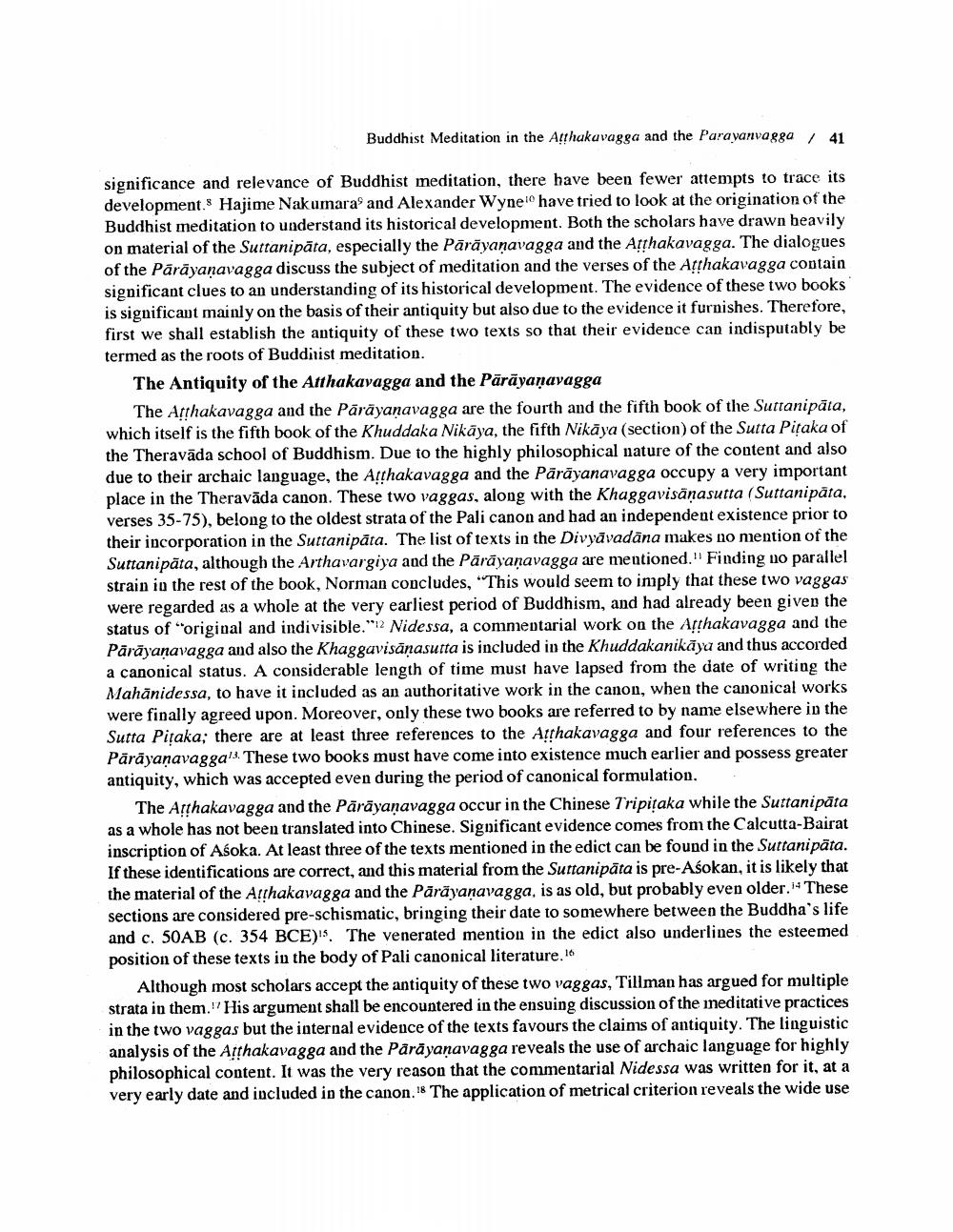________________
Buddhist Meditation in the Athakavagga and the Parayanvagga / 41
significance and relevance of Buddhist meditation, there have been fewer attempts to trace its development. Hajime Nakumara and Alexander Wynel have tried to look at the origination of the Buddhist meditation to understand its historical development. Both the scholars have drawn heavily on material of the Suttanipāta, especially the Pārāyaṇavagga and the Athakavagga. The dialogues of the Pārāyaṇavagga discuss the subject of meditation and the verses of the Atthakavagga contain significant clues to an understanding of its historical development. The evidence of these two books is significant mainly on the basis of their antiquity but also due to the evidence it furnishes. Therefore, first we shall establish the antiquity of these two texts so that their evidence can indisputably be termed as the roots of Buddivist meditation.
The Antiquity of the Atthakavagga and the Pārāyaṇavagga
The Atthakavagga and the Pārāyaṇavagga are the fourth and the fifth book of the Suttanipāta, which itself is the fifth book of the Khuddaka Nikāya, the fifth Nikāya (section) of the Sutta Pitaka of the Theravāda school of Buddhism. Due to the highly philosophical nature of the content and also due to their archaic language, the Atthakavagga and the Pārāyanavagga occupy a very important place in the Theravāda canon. These two vaggas, along with the Khaggavisāņasutta (Suttanipāta, verses 35-75), belong to the oldest strata of the Pali canon and had an independent existence prior to their incorporation in the Suttanipāta. The list of texts in the Divyāvadāna makes no mention of the Suttani pāta, although the Arthavargiya and the Pārāyanavagga are mentioned." Finding no parallel strain in the rest of the book, Norman concludes, "This would seem to imply that these two vaggas were regarded as a whole at the very earliest period of Buddhism, and had already been given the status of original and indivisible."2 Nidessa, a commentarial work on the Atthakavagga and the Pārāyanavagga and also the Khaggavisāṇasutta is included in the Khuddakanikāya and thus accorded a canonical status. A considerable length of time must have lapsed from the date of writing the Mahānidessa, to have it included as an authoritative work in the canon, when the canonical works were finally agreed upon. Moreover, only these two books are referred to by name elsewhere in the Sutta Pitaka; there are at least three references to the Arthakavagga and four references to the Pārāyaṇavaggal. These two books must have come into existence much earlier and possess greater antiquity, which was accepted even during the period of canonical formulation.
The Arthakavagga and the Pārāyaṇavagga occur in the Chinese Tripitaka while the Suttanipāta as a whole has not been translated into Chinese. Significant evidence comes from the Calcutta-Bairat inscription of Asoka. At least three of the texts mentioned in the edict can be found in the Suttani pāta. If these identifications are correct, and this material from the Suttanipāta is pre-Asokan, it is likely that the material of the Atthakavagga and the Pārāyaṇavagga, is as old, but probably even older. These sections are considered pre-schismatic, bringing their date to somewhere between the Buddha's life and c. 50AB (c. 354 BCE)'. The venerated mention in the edict also underlines the esteemed position of these texts in the body of Pali canonical literature.16
Although most scholars accept the antiquity of these two vaggas, Tillman has argued for multiple strata in them. His argument shall be encountered in the ensuing discussion of the meditative practices in the two vaggas but the internal evidence of the texts favours the claims of antiquity. The linguistic analysis of the Atthakavagga and the Parāyanavagga reveals the use of archaic language for highly philosophical content. It was the very reason that the commentarial Nidessa was written for it, at a very early date and included in the canon. The application of metrical criterion reveals the wide use




